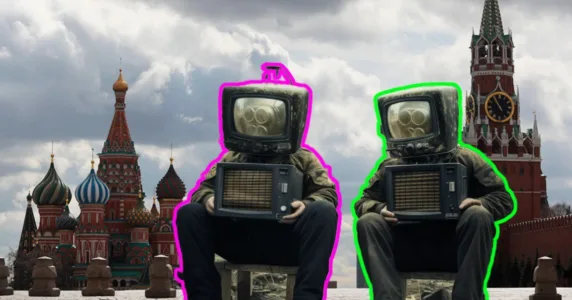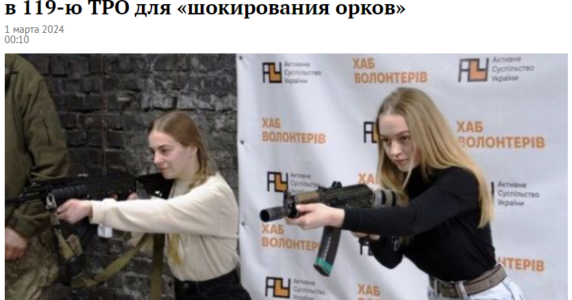Navigation and useful materials
Disinformation is an integral part of Russian aggression against Ukraine, which began in 2014. During the full-scale invasion, Kremlin propaganda generated a new batch of fakes of various levels of absurdity. “Combat mosquitoes” and a “dirty bomb” have become memes as once did the “crucified boy” and the “business card of Yarosh.”
In 2023, disinformation kept on spreading. The Centre for Strategic Communication and Information Security has collected the most high-profile fakes spread by the Russians in the information space in the second year of the full-scale war.
1. “Budanov in a coma,” “disappearance” of Zaluzhnyi and other generals
The command of the Defence Forces of Ukraine suffered regular information attacks from the enemy in 2023. The Russians repeatedly disseminated fakes about the serious injuries allegedly suffered by Ukrainian military leaders as a result of an attack on the building of the Main Directorate of Intelligence in Kyiv, on the “headquarters in Pavlodar,” or under other circumstances. In June, propagandists, citing a non-existent report by a German publication, said that Kyrylo Budanov, the chief of the Intelligence Directorate, was “in a coma.”

The most aggressive campaign took place in May: the Russians spread hysterical fakes about the “disappearance” of Valerii Zaluzhnyi, the Commander-in-Chief of the Armed Forces of Ukraine, and also managed to “kill” Oleksandr Syrskyi, the Commander of the Land Forces, and Ihor Tantsiura, the Commander of the Territorial Defence Forces.
The fake about the death of Tantsiura was spread personally by Yevgeny Prigozhin, the founder of the Wagner PMC, who was later liquidated in Russia after an unsuccessful coup.
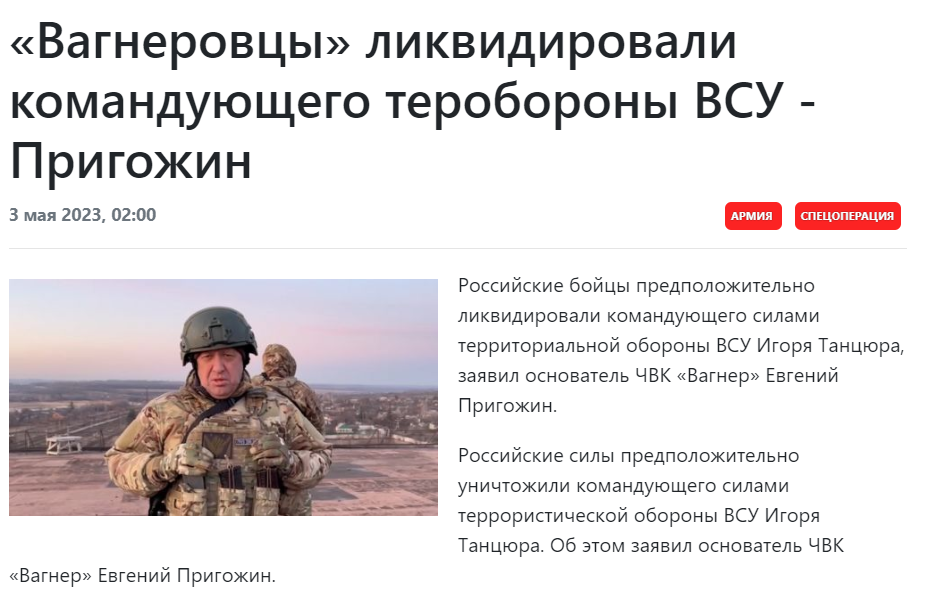
2. Zaluzhnyi’s deepfake coup
Deepfakes with Zaluzhnyi continued the information campaign about the confrontation between President Volodymyr Zelenskyy and the Commander-in-Chief of the Armed Forces of Ukraine. The general’s AI-generated voice was used in the altered video. Zaluzhnyi “accuses” the president of “treason” and calls on the military to use weapons against the Ukrainian authorities.
This year’s videos were of a better quality than the last year’s deepfake with Zelenskyy. But just like in March 2022, Ukrainians did not buy it.
В эфире одного из украинских каналов сегодня появилась бегущая строка, где говорилось, что Зеленский объявил о капитуляции. Одновременно в мессенджерах стали рассылать дипфейк-видео с Зеленским, который тоже говорит о сдаче. Посмотрите, как на это отреагировал настоящий Зеленский pic.twitter.com/bdzJA9v9qi
— Настоящее Время (@CurrentTimeTv) March 16, 2022
3. “HIMARS shelling” and other fakes about the blowing up of the Kakhovka HPP
On June 6, 2023, Ukraine suffered the largest environmental disaster in more than 30 years of its independence. The explosion and destruction of the dam of the Kakhovka hydroelectric power plant led to flooding and pollution of huge areas in the South. Numerous evidence of mining of the HPP by the occupiers and periodic threats to blow up the dam did not prevent Russian propagandists from littering the information space with fakes about the “Ukrainian sabotage.” Z-bloggers wrote with confidence about a missile strike, the consequences of shelling by “HIMARS,” and the deliberate raising of the water level by Ukrainians for additional pressure on the dam.

They also avidly explained that the explosion at the HPP was allegedly “in Ukraine’s interest.” They did not fail to mention that its consequences significantly complicated the offensive of the Armed Forces of Ukraine. To enhance the effect, the propagandists tried to promote the topic of preparing another “anti-Russian provocation”: the blowing up of the Kremenchuk HPP “according to the Kakhovka scenario.”
4. Warehouses of weapons at nuclear power plants and “attacks” on the Zaporizhzhia NPP
One of the topics of nuclear hysteria, along with threats of its use and accusations of Ukraine of creating a “dirty bomb,” were accusations about the transformation of nuclear energy facilities into military ones. In September, Kremlin propaganda claimed that the Armed Forces allegedly stored Western weapons at the Rivne and Khmelnytskyi nuclear power plants. This accusation was refuted not only by the Ukrainian authorities, but also by the International Atomic Energy Agency. IAEA inspectors did not see any violations anywhere other than Enerhodar captured by the Russians. The militarization of nuclear power plants is a consistent tactic of the Russians. The occupiers turned the Zaporizhzhia NPP into a military base, placing artillery, air defence systems there, and using it to shell Marhanets, Nikopol, and other cities. Because of their confidence in their own impunity, the Russians also periodically accused Ukraine of preparing for artillery shelling of nuclear power plants or UAV attacks on spent fuel storage facilities.
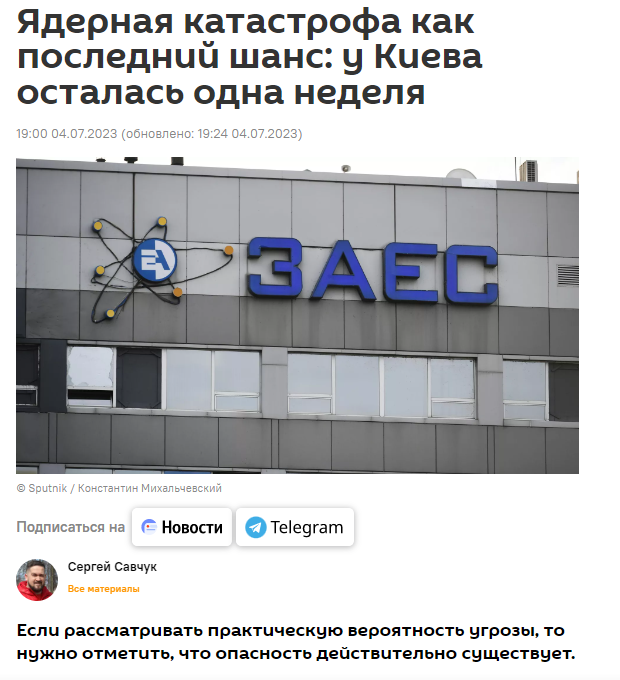
5. Mobilization of women and adolescents
The disruption of mobilization, a decrease in trust in the military-political leadership, and the demoralization of citizens remain the strategic task of Russian information and psychological special operations in Ukraine. The Russians have been making regular statements about the perspective of the general mobilization of women, in particular, pregnant women, as well as lowering the conscription age to 16 years since the beginning of the full-scale war.
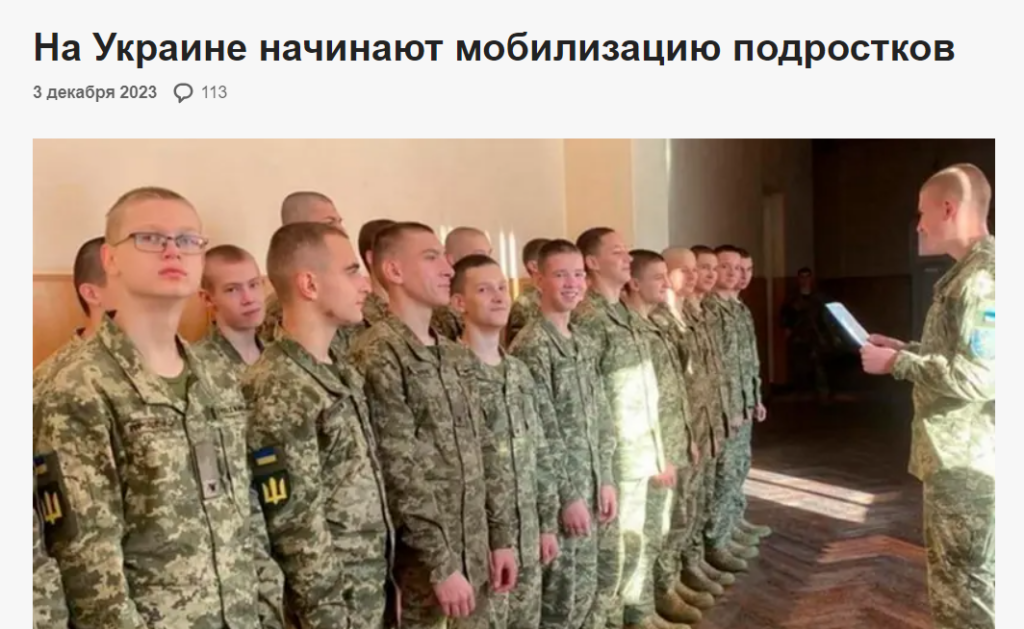
In 2023, activities in this area only intensified in view of the real discussion in Ukraine on improving the mobilization and developing amendments to the legislation. Of course, there are no provisions invented by Russian fake makers in any draft law.
6. HAMAS fighters have Ukrainian weapons
The Russians took advantage of the outbreak of war in the Gaza Strip and launched a new discrediting campaign against Ukraine. Propaganda quickly shifted from empty words of Z-bloggers to fabricated photos, videos, and “high-profile revelations” on federal TV channels and pages of online publications.

The propagandists did not provide any tangible evidence that HAMAS had weapons from Ukraine. Instead, there are numerous facts of the fighters’ use of weapons having Russian origin: from traditional Kalashnikov assault rifles to modern Kornet ATGMs.
7. “New Jerusalem” on the territory of Ukraine
This is not just a fake, but a full-fledged conspiracy theory, one of the variations of the “Jewish conspiracy.” Its essence lies in the fact that with the support of the Ukrainian authorities, the Jews allegedly plan to buy or otherwise seize part of the territory of Ukraine and settle it. For more than 10 years, the supporters of this theory in Ukraine were exclusively people on the fringes of society, but in 2023, the conspiracy theory was given a new life. The spread of “revealing” publications on social networks intensified in October against the background of aggravation in the Middle East.

In particular, many video messages from Ilya Kyva and other dubious bloggers appeared on TikTok, as well as excerpts from old interviews with conspiracy theorist Ihor Berkut who has been wanted since 2020 on suspicion of high treason.

8. Foreign citizenship of the Zelenskyys
The wife of the President of Ukraine has repeatedly been the target of enemy information attacks. In 2023, Russian fake makers periodically “found” her passports of foreign states. In summer, it was Israel, in autumn, it was Russia.
However, the validity of the “Israeli passport” expired the day before the date of its issuance, and the photo was taken from the social networks of the first lady.

Olena Zelenska’s “Russian passport” was also full of errors, and its fake nature could be seen by the inconsistencies in the data: the document with the Kamchatka series was allegedly issued in the occupied Crimea. But it was not the end for fakes with the passport. Traitor Illia Kyva claimed that the Zelenskyys; Andrii Yermak, the head of the Presidential Office; Kyrylo Budanov, the chief of the Intelligence Directorate; and Oleksii Reznikov, the ex-Minister of Defence had British citizenship; while Valerii Zaluzhnyi, the commander-in-chief of the Armed Forces of Ukraine, had American citizenship. Soon, Kyva stopped spreading fake news.
On the eve of Christmas, the Russians spread another passport-related fake: allegedly, the children of Rustem Umerov, the current Minister of Defence of Ukraine, have a U.S. citizenship.
9. Olena Zelenska buys jewellery and traffics children
The Nigerian publication The Nation was the source of the “Zelenska’s jewellery” story: it posted a photo of a receipt from a Cartier store for USD 1 mln. The Ukrainian first lady allegedly spent this amount on jewellery on September 22 in New York. Not that it matters that she was not in the United States that day, but in the capital of Canada.
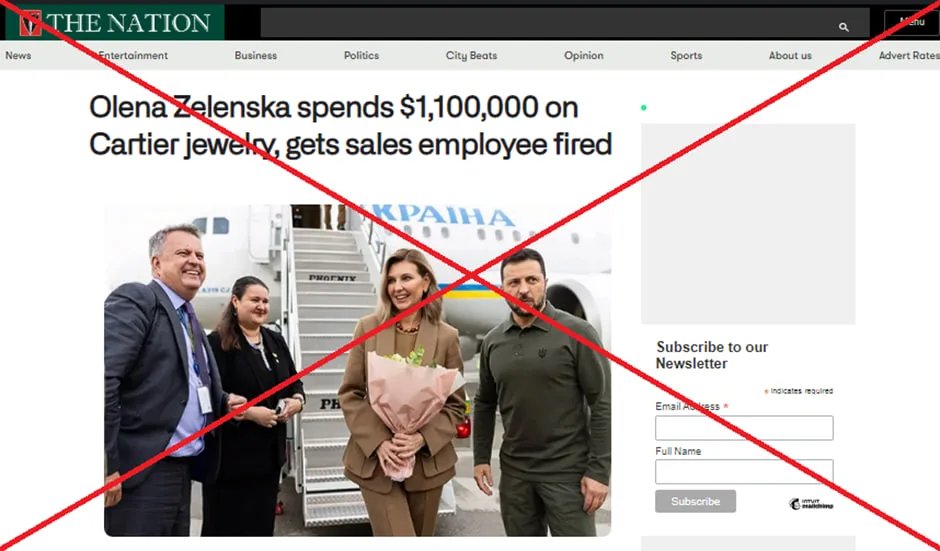
According to the fake news, the source of funds could be income from trafficking in children, in which the Olena Zelenska Foundation is allegedly involved. In November, “incriminating materials” about this appeared on English-language garbage sites specializing in anti-Ukrainian fakes. Of course, there was no evidence, and the authors were fictional persons, which could not even be found on Google. The cynicism of fake news about Ukrainian children also stressess the fact that Russian occupiers are engaged in their abduction in the occupied territories. It was for this crime that the International Criminal Court issued a warrant for the arrest of Russian President Putin and the children’s ombudsman Lvova-Belova.
10. Egyptian villa of Zelenskyy’s mother-in-law
Again, the Nigerian media. At the end of the summer, they, citing a “well-known investigative journalist,” reported that Volodymyr Zelenskyy allegedly purchased a villa for his mother-in-law Olha Kyiashko. The author of the material turned out to be so “famous” that there was no information about him on Google before the publication of the “investigation.” His YouTube channel had been created a few days before that.
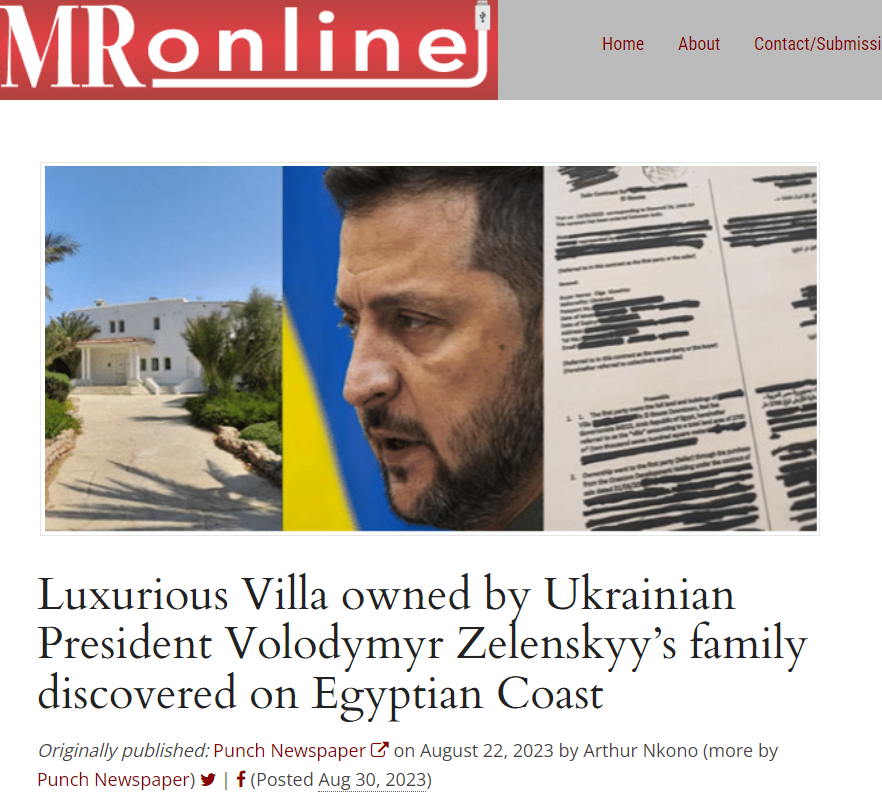
The fake was quickly picked up by Russian Telegram channels and other propaganda media.
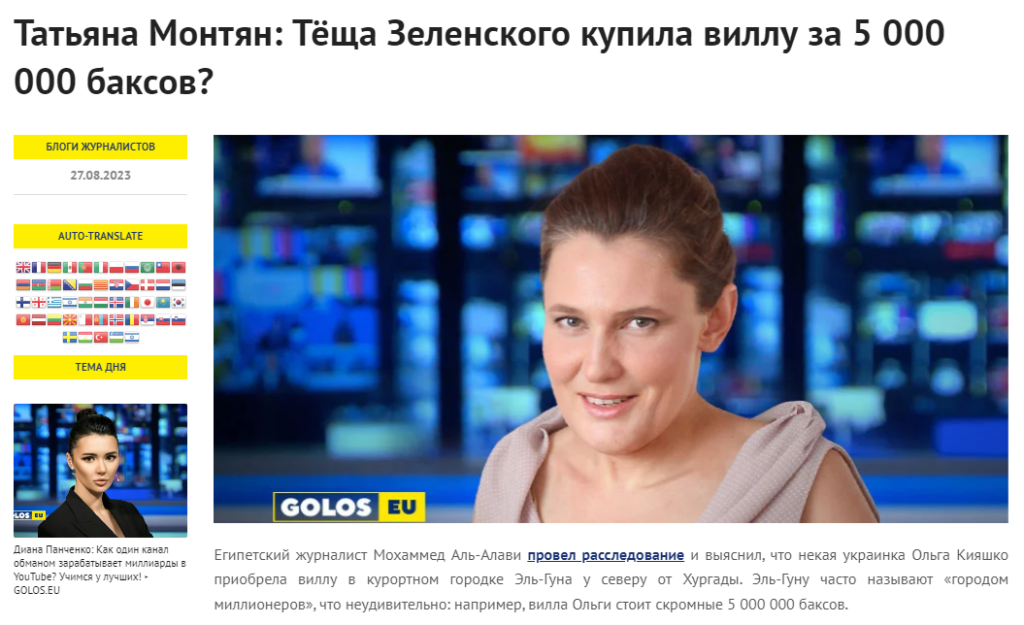
The published documents used an incorrect transliteration of the surname Kyiashko, and their origin remained “secret.” This accusation reminded us of the last year’s “investigation” into the “Moscow real estate of Zelenskyy’s mother-in-law.” The owner of the flat, mentioned by Tsargrad, the publication of the Orthodox oligarch Malofeev, was Olha Kiyashko. She was not Zelenskyy’s mother-in-law, but her namesake and, which is more, 12 years younger.
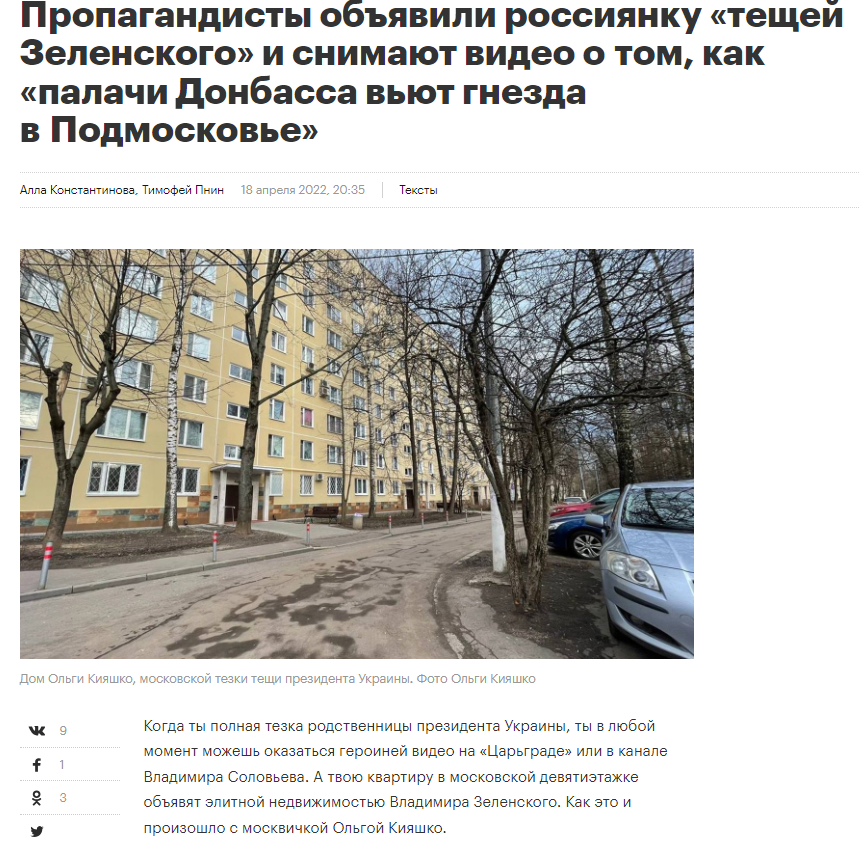
In addition to Zelenskyy’s mother-in-law, the closest relatives of other Ukrainian officials turned out to be the owners of foreign real estate this year in the stories of Russian propaganda. The Russians “found” a villa in Cannes belonging to Reznikov’s daughter, and Zaluzhnyi’s daughter “owned” one in the Canary Islands.
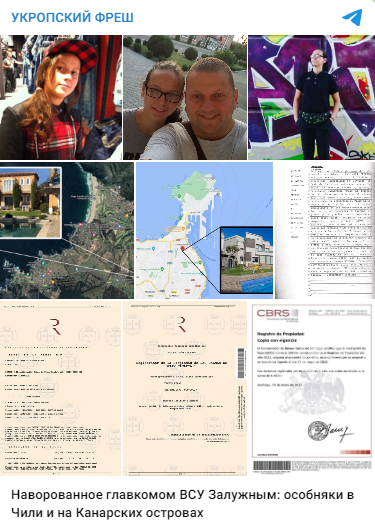
TikTok used a botnet to spread videos with AI-generated voiceovers in different languages.
Lies remain the Kremlin’s traditional weapon. Russian propaganda seeks to confuse, intimidate, sow panic and distrust, make people believe in conspiracy theories, and exacerbate divisions in society. If in 2022, the Kremlin filled the information space with “combat mosquitoes,” “dirty bombs,” and “bio-laboratories,” in 2023, it focused mainly on attacks against the Ukrainian military-political leadership and their relatives. The Russians also generated new fakes to promote old narratives about “total corruption,” “embezzlement of assistance,” and accusing Ukrainians of the crimes Russia committed.
The military and propaganda machine of the Kremlin can and must be defeated. Ukraine has repeatedly proved this and will do so in the future.
Військову і пропагандистську машину Кремля можна і треба перемагати. Україна неодноразово це доводила. І доведе в майбутньому.
If you have found a spelling error, please, notify us by selecting that text and pressing Ctrl+Enter.
